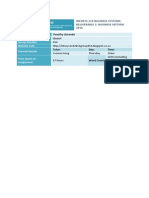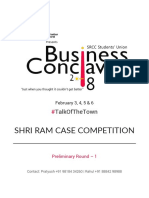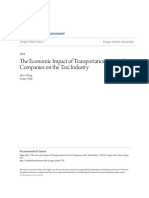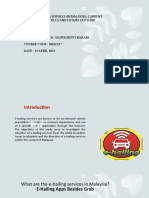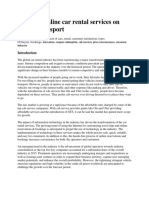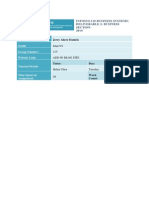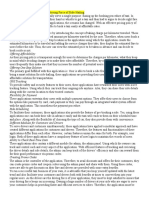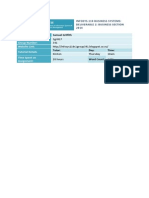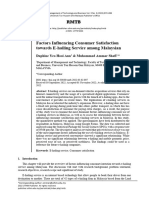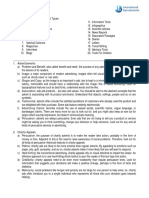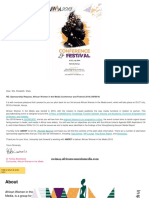0 ratings0% found this document useful (0 votes)
364 viewsGrace Li: Infosys.110 Business Systems: Deliverable 2: Business Section 2014
Grace Li: Infosys.110 Business Systems: Deliverable 2: Business Section 2014
Uploaded by
ggliiiixxThis document provides details about a proposed taxi service business aimed at improving safety for young women in Auckland, New Zealand. The business would offer an exclusive taxi service driven by women for women customers. It would also provide a mobile app to allow customers to track their taxi, call emergency services with one button, and communicate with friends. The document outlines the industry analysis, target customers and their needs, product and service description, key business processes and functionalities to deliver the service. The overall strategy is described as focused high cost, targeting young women and students specifically with an emphasis on quality and safety.
Copyright:
© All Rights Reserved
Available Formats
Download as DOCX, PDF, TXT or read online from Scribd
Grace Li: Infosys.110 Business Systems: Deliverable 2: Business Section 2014
Grace Li: Infosys.110 Business Systems: Deliverable 2: Business Section 2014
Uploaded by
ggliiiixx0 ratings0% found this document useful (0 votes)
364 views10 pagesThis document provides details about a proposed taxi service business aimed at improving safety for young women in Auckland, New Zealand. The business would offer an exclusive taxi service driven by women for women customers. It would also provide a mobile app to allow customers to track their taxi, call emergency services with one button, and communicate with friends. The document outlines the industry analysis, target customers and their needs, product and service description, key business processes and functionalities to deliver the service. The overall strategy is described as focused high cost, targeting young women and students specifically with an emphasis on quality and safety.
Original Description:
.
Original Title
D2
Copyright
© © All Rights Reserved
Available Formats
DOCX, PDF, TXT or read online from Scribd
Share this document
Did you find this document useful?
Is this content inappropriate?
This document provides details about a proposed taxi service business aimed at improving safety for young women in Auckland, New Zealand. The business would offer an exclusive taxi service driven by women for women customers. It would also provide a mobile app to allow customers to track their taxi, call emergency services with one button, and communicate with friends. The document outlines the industry analysis, target customers and their needs, product and service description, key business processes and functionalities to deliver the service. The overall strategy is described as focused high cost, targeting young women and students specifically with an emphasis on quality and safety.
Copyright:
© All Rights Reserved
Available Formats
Download as DOCX, PDF, TXT or read online from Scribd
Download as docx, pdf, or txt
0 ratings0% found this document useful (0 votes)
364 views10 pagesGrace Li: Infosys.110 Business Systems: Deliverable 2: Business Section 2014
Grace Li: Infosys.110 Business Systems: Deliverable 2: Business Section 2014
Uploaded by
ggliiiixxThis document provides details about a proposed taxi service business aimed at improving safety for young women in Auckland, New Zealand. The business would offer an exclusive taxi service driven by women for women customers. It would also provide a mobile app to allow customers to track their taxi, call emergency services with one button, and communicate with friends. The document outlines the industry analysis, target customers and their needs, product and service description, key business processes and functionalities to deliver the service. The overall strategy is described as focused high cost, targeting young women and students specifically with an emphasis on quality and safety.
Copyright:
© All Rights Reserved
Available Formats
Download as DOCX, PDF, TXT or read online from Scribd
Download as docx, pdf, or txt
You are on page 1of 10
1
INFOSYS.110 BUSINESS SYSTEMS:
DELIVERABLE 2: BUSINESS SECTION
2014
Name Grace Li
NetID gli900
Group Number: 323
Website Link: http://infosys110group323.blogspot.co.nz/
Tutorial Details
Tutor: Day: Time:
Kirstin Thursday 12pm
Time Spent on
Assignment:
25 hours Word Count: 1648
2
2
TAXI SERVICE ENSURING SAFETY
INTRODUCTION
Changing perceptions of public safety in the Auckland CBD area show the effects of well
publicised attacks and perceived dangers associated with New Zealands dangerous
nightlife. A report by Dr Cathy Casey and Prof Charles Crothers (p. 9, 2005) shows "at least
50% of respondents felt it was unsafe to be alone in the city after dark". An increased
number of attacks taking place at night in the Auckland CBD area have impacted the
attitude towards safety for young women. Therefore, my chosen problem is the safety of
young women at night in the Auckland CBD area. My solution to help young women feel
safer at night is the use of a taxi service, driven by women, for women. Alongside the taxi
service is an associated mobile app which provides a product and service to meet the needs
of safety for women.
3. BUSINESS SECTION
3.1 Vision
To offer an exclusive taxi service as a mode of transport for women, driven by women and
ensuring customers always feel safe and connected with simply a touch of a button.
3.2 Industry Analysis: NZ Taxi Service Industry
Industry: NZ Taxi Service Industry.
Force: High/Low: Justification:
Buyer power: High 7 major taxi companies operate in Auckland offering
consumers many choices to select from (View
Auckland, n.d.). Many choices for the consumer
results in high buyer power.
3
3
Supplier
power:
Low Supplier power is low due to the variety of car
manufacturers available for taxi businesses to choose
from. In NZ, all taxis require certified vehicle security
cameras. There are many choices, around 19 makes
and models, from which the taxi company can select
from (NZ Transport Agency, n.d.).
Threat of new
entrants:
High Barriers to entry in the taxi industry is low.
Deregulation of the taxi industry in 1989 (Cumming,
2014). This meant there were no restrictions on the
number of taxis operating within the industry,
allowing new competitors to easily enter the market.
Low cost, skill and knowledge required in order to
enter this industry.
Threat of
substitutes:
High There are many alternatives to taking taxis, such as
catching the bus, train or other public transport. Also
possible to walk or carpool with others. High number
of alternatives means threat of substitutes to the
industry is high.
Rivalry among
existing
competitors:
High Resulting from low barriers to entry is the high
competition between taxi companies as they try to
compete through price or branding of their business.
The bigger taxi corporations such as Co-Op and Alert
try to buy out smaller businesses as a way to reduce
competition (Tolerton, 2012). However, the rivalry
among existing competitors is high.
4
4
Overall attractiveness of the industry: The taxi service industry in NZ is unattractive
because of large numbers of taxi companies already operating in this industry, high rivalry
and high buyer power. In addition, deregulation of the taxi industry results in new
competitors to easily enter and increase competition and rivalry. The taxi service industry
also has to compete with the high number of substitutes and is overall not an industry in
which taxi companies have power, therefore making this a relatively unattractive industry.
3.3 Customers and Thei r Needs
An Auckland Council study showed that 52% of women were impacted by crime and had
negative safety perceptions, (2012). The study also found that 51% of women felt unsafe if
they were to wait for a bus at night. Young women are a target group of customers as they
require a service and mode of transport which can ensure their safety and put their mind at
ease.
Auckland city is home to two tertiary institutions, many of these students live in or around
the CBD area. 40% of young people visit the Auckland CBD area at night fairly often,
(Auckland Council, 2012), putting them at a potential risk of attacks. The busy nightlife often
results in groups of friends splitting up, or being alone with no safe way back home.
Students are therefore a prime group this service is targeted towards. They require a service
which can keep them in contact with friends and the ability to get home safely.
3.4 The Product and Service
The taxi service driven by women ensures the target groups of young women and students
feel more comfortable and provides a safe mode of transport that is efficient and makes
certain that customers arrive safely at their destination.
The associated app enables customers to connect to emergency services by simply pushing
a button. The ability to contact family and friends throughout the journey provides
reassurance to both the customer and their contacts. Tracking of the taxi further improves
the safety of customers as they can see how far away the taxi is reducing the risks for
customers as they no longer need to wait for their taxi to arrive in an unsafe place.
5
5
3.5 Suppliers and Partners
An app store, Apple Store, is a partner of the business as they provide a platform to
promote and sell the businesss product. They operate alongside the business and both
parties will earn monetary benefit. Within the businesss app there is an SOS button that
links to emergency services. Therefore, emergency services work with the business to
provide a sense of safety and ensure customers know that they are simply a press of a
button away from getting help.
A taxi business requires vehicles or cars in order to provide their service. Car manufacturers
such as Toyota or Holden supply and sell their vehicles to the taxi business and are regarded
as suppliers when they contribute an input in order for taxi businesss to provide their
transport service. NZ taxi operators require licensed vehicle security cameras, therefore a
supplier would be a company such as VerifEye because they produce a product that allows
the taxi business to effectively deliver their service.
3.6 Strategy: Focused High Cost
This business is high cost because it provides high quality service by ensuring the safety of
customers. The associated app improves efficiency and provides further reassurance.
Scope of the business is narrow as it targets an exclusive service to only young women and
students.
The overall strategy is Focused High Cost.
3.7 Value Chain Activity: Deliver the product/service
The most important value chain activity for this business is Deliver the product/service.
The main activity for this business is physically providing car rides for the target group of
customers. Delivering the product/service links with the vision of offering a safe mode of
transport to the customers. Furthermore, the business also performs the delivery of the
service at a high quality level to ensure the safety of the customers, thus resulting in the
service to be high cost and targeted to a narrow market of young women and students.
6
6
3.8 Business Processes
3.8.1. TAXI BOOKING PROCESS A booking request by the customer is received by the
Booking Management System. Customer details such as pick-up location, contact number
and desired destination are processed. Taxis are tracked by GPS location to find the nearest
available taxi to the customer and ensure quick pick-up time. The taxi driver will be
forwarded customer details and journey plans. The final step in the process is a
confirmation from the company to the customer with details on the taxi that will perform
the service.
Start
Receive request for
taxi
Record customer
details and place of
pick up
Track location of
nearest taxi by GPS
Send pick-up and
destination
locations to taxi
Confirm taxi
booking request
End
Customer Service
Deparment
Booking Management
System
7
7
3.8.2. CUSTOMER PAYMENT PROCESS Occurs at the end of a journey and begins with the
final calculation of the bill based on the records of the journey. Using an invoice
management system, an invoice is created and sent to the customer through the mobile
app. After which, the customer is able to pay directly through the app. Confirmation occurs
instantly so customers know their money has been transferred, ending the customer
payment process.
Start
Record taxi journey
log
Create and send
invoice
Customer receives
invoice
Payment of invoice
through app
Confirm payment
received
End
Invoicing Department Payment Processing
System
8
8
3.9 Functionalities
3.9.1. TAXI BOOKING PROCESS
Tracking location of personnel and taxis
Recording customer details and the place of pickup and destination
3.9.2. CUSTOMER PAYMENT PROCESS
Creating and sending invoice
Receiving customer payment
3.10 Systems
3.10. 1. BOOKING MANAGEMENT SYSTEM This system organizes and helps manage booking
requests. It incorporates the ability to record necessary customer details, improving the
speed at which information is passed between the customer and the business. Booking
process becomes more efficient and accurate, ensuring the least amount of time is taken
before a taxi arrives to pick up the customer. This supports the vision of delivering a more
efficient and safer way of transport, customers do not have to wait in potentially dangerous
areas for a booking to be confirmed.
3.10. 2. PAYMENT PROCESSING SYSTEM Incorporates the ability to automatically create,
send and receive invoices during the customer payment process. Automation of the process
leads to increased efficiency and supports the vision of the company. Customers can quickly
pay their fare through the app and confirmation occurs instantly so they know their money
has reached its desired destination
3.10. 3. PERSONNEL MANAGEMENT SYSTEM The business needs to track the locations of all
operating company taxis to determine the nearest available taxi. A personnel management
system can control and view the routes taken by their drivers enabling quicker pick-up times
for customers as the closest driver is the one who is contacted to deliver the service. This
supports the vision of delivering a more efficient and safer way of transport.
9
9
3.11. Summary Table: Value Chain to Systems
Value Chain
Activity
Processes Functionalities Specific Information
System(s)
Broad Information
System(s)
Deliver the
product/service
1. Taxi Booking
Process
1. Recording customer details and the place
of pick up and destination.
2. Tracking personnel and taxis.
Booking Management
System
Personnel Management
System
Transaction Processing
System
Supply Chain
Management
2. Customer
Payment
Process
1. Creating and sending invoices.
2. Receiving customer payments.
Invoice Management
System
Payment processing system
Transaction Processing
System
Transaction Processing
System
10
10
CONCLUSION
This exclusive taxi service, driven by women and specifically for women, is a business that
exists to deliver a safer means of travel and to help young women and students feel safer at
night. Information systems are very valuable to this organisation as the systems add value
by improving efficiency due to increasing the speed and accuracy at which relevant
information is passed between customers to the business and also within the business. This
ensures a high quality service is carried out to meet the needs of the customer, creating
competitive advantage due to exceptional customer service. Improved efficiency also
reduces cycle time for the business meaning they are able to service an increased number of
customers, thus leading to greater profit.
REFERENCES
1. View Auckland. (n.d.). Auckland taxi companies, view auckland. Retrieved from
http://www.viewauckland.co.nz/whatson/auckland-taxi-companies-
recommended-auckland-712.html
2. NZ Transport Agency. (n.d). Approved in-vehicle security camera systems. Retrieved
from
http://www.nzta.govt.nz/commercial/passenger/security-cameras.html
3. Cumming, G. (2014). Taxis why youre paying so much. NZ Herald. Retrieved from
http://www.nzherald.co.nz/nz/news/article.cfm?c_id=1&objectid=11256412
4. Tolerton, J. (2012). Taxis and cabs taxi industry deregulation. Te Ara- the
Encyclopedia of New Zealand. Retrieved from
http://www.teara.govt.nz/en/taxis-and-cabs/page-3
5. Auckland City. (2012). Public perceptions of safety from crime in the Auckland region.
Auckland, New Zealand.
http://www.aucklandcouncil.govt.nz/EN/planspoliciesprojects/councilpolicies/cc
tv/Documents/publicperceptionsofsafetyfromcrimereport.pdf
6. Casey, C., & Crothers, C. (2005). Perceptions of public safety in the Auckland CBD.
Auckland, New Zealand.
http://www.police.govt.nz/district/aucklandcity/perceptions-of-public-safety-in-
auckland.pdf
You might also like
- Feasibility Report On Car Rental ServicesDocument24 pagesFeasibility Report On Car Rental Servicesakshay60% (5)
- Hunter The Reckoning - 2 Page Character SheetDocument2 pagesHunter The Reckoning - 2 Page Character SheetConsignmenttoduat0% (1)
- Certificate of AnalysisDocument3 pagesCertificate of AnalysisbrayanNo ratings yet
- SolaX Power Troubleshooting X3 Hybrid PDFDocument16 pagesSolaX Power Troubleshooting X3 Hybrid PDFmarketingsunfix sunfixNo ratings yet
- Analyzing Architecture: Laurie Baker Loyola Chapel, TrivandrumDocument2 pagesAnalyzing Architecture: Laurie Baker Loyola Chapel, TrivandrumSalman LatiwalaNo ratings yet
- Business Strategy by Haroon AkramDocument15 pagesBusiness Strategy by Haroon AkramharoonNo ratings yet
- Courtney Yule: Cyul074Document9 pagesCourtney Yule: Cyul074Courtney YuleNo ratings yet
- INFOSYS110 2014 Deliverable 02 Improving Auckland's TransportDocument11 pagesINFOSYS110 2014 Deliverable 02 Improving Auckland's TransportMelissaLynNo ratings yet
- Name Netid Group Number: Website Link: Tutorial Details Time Spent On AssignmentDocument12 pagesName Netid Group Number: Website Link: Tutorial Details Time Spent On Assignmentsbut219No ratings yet
- Name Netid Group Number: Website Link: Tutorial Details Time Spent On AssignmentDocument10 pagesName Netid Group Number: Website Link: Tutorial Details Time Spent On Assignmentpli415No ratings yet
- Kzzam' A Magical Solution To CongestionDocument8 pagesKzzam' A Magical Solution To CongestionKhaninja KaushishNo ratings yet
- INFOSYS110 2014 Deliverable 02 TemplateDocument12 pagesINFOSYS110 2014 Deliverable 02 Templatexlu555No ratings yet
- INFOSYS110 2014 DELIVERABLE 2 ASSIGNMENT - Timothy LlorandoDocument10 pagesINFOSYS110 2014 DELIVERABLE 2 ASSIGNMENT - Timothy Llorandotllo664No ratings yet
- Shri Ram Case CompetitionDocument10 pagesShri Ram Case CompetitionAbhishek BajpaiNo ratings yet
- Jeeva PDFDocument70 pagesJeeva PDFJeeva SNo ratings yet
- Name Netid Group Number: Website Link: Tutorial Details Time Spent On AssignmentDocument10 pagesName Netid Group Number: Website Link: Tutorial Details Time Spent On AssignmentCavinTohNo ratings yet
- Yasha Mae Gonzales: Name Netid Group Number: Website Link: Tutorial Details Time Spent On Assignme NTDocument5 pagesYasha Mae Gonzales: Name Netid Group Number: Website Link: Tutorial Details Time Spent On Assignme NTYasha Mae GonzalesNo ratings yet
- Document 1Document5 pagesDocument 1hussainfawad1313No ratings yet
- MPRDocument45 pagesMPRKaran Batheja86% (7)
- Transportation Research Part E: Xiaolei Wang, Fang He, Hai Yang, H. Oliver GaoDocument20 pagesTransportation Research Part E: Xiaolei Wang, Fang He, Hai Yang, H. Oliver GaosdfsahdNo ratings yet
- BRM Cat1Document8 pagesBRM Cat1Swti BhattNo ratings yet
- Measuring The PerformanceDocument11 pagesMeasuring The PerformanceDrRam Singh KambojNo ratings yet
- MPRDocument45 pagesMPRAryan ThakurNo ratings yet
- The Economic Impact of Transportation Network Companies On The Taxi IndustryDocument39 pagesThe Economic Impact of Transportation Network Companies On The Taxi IndustryKC ToraynoNo ratings yet
- Name Netid Group Number: Website Link: Tutorial Details Time Spent On AssignmentDocument11 pagesName Netid Group Number: Website Link: Tutorial Details Time Spent On Assignmentssun995No ratings yet
- E-Hailing Services in Malaysia: Current Practices and Future OutlookDocument12 pagesE-Hailing Services in Malaysia: Current Practices and Future OutlookHanimNo ratings yet
- Mis Proooojectt Copy 2Document8 pagesMis Proooojectt Copy 2zara afridiNo ratings yet
- Dissertation ChinmayThippaniDocument46 pagesDissertation ChinmayThippaniSoham Dutta0% (1)
- Name Netid Group Number: Website Link: Tutorial Details Time Spent On AssignmentDocument11 pagesName Netid Group Number: Website Link: Tutorial Details Time Spent On Assignmentcrus500No ratings yet
- New ProposalDocument19 pagesNew ProposalDilini LiyanageNo ratings yet
- Minor Project On "A Comparative Study of Customer Satisfaction Towards The Transportation Service With Special Reference To Taxi Companies - Ola Cabs and Uber Cabs"Document43 pagesMinor Project On "A Comparative Study of Customer Satisfaction Towards The Transportation Service With Special Reference To Taxi Companies - Ola Cabs and Uber Cabs"zaid khanNo ratings yet
- Online Car Rental EffectDocument5 pagesOnline Car Rental EffecthimanshuNo ratings yet
- Name Netid Group Number: Website Link: Tutorial Details Time Spent On AssignmentDocument10 pagesName Netid Group Number: Website Link: Tutorial Details Time Spent On AssignmentWenny14No ratings yet
- INFOSYS110 2014 Deliverable 02 TemplateDocument9 pagesINFOSYS110 2014 Deliverable 02 TemplateNancyZhangNo ratings yet
- SWOTDocument7 pagesSWOTNg JZNo ratings yet
- Name Netid Group Number: Website Link: Tutorial Details Time Spent On AssignmentDocument10 pagesName Netid Group Number: Website Link: Tutorial Details Time Spent On AssignmentShioriSaitoNo ratings yet
- Name Netid Group Number: Website Link:: Jerry Ahere DanielsDocument10 pagesName Netid Group Number: Website Link:: Jerry Ahere DanielsJerry Tom-Tom DanielsNo ratings yet
- Unit VIII Economics - Nguyen Duy SonDocument15 pagesUnit VIII Economics - Nguyen Duy SonsonndNo ratings yet
- Name Netid Group Number: Website Link: Tutorial Details Time Spent On AssignmentDocument11 pagesName Netid Group Number: Website Link: Tutorial Details Time Spent On AssignmentNancyZhangNo ratings yet
- SPM Prac Dimagram Tybscit Sem 6Document31 pagesSPM Prac Dimagram Tybscit Sem 6bhlmallahNo ratings yet
- Arketing Trategy of Axi For SureDocument9 pagesArketing Trategy of Axi For SureAnshuman PandeyNo ratings yet
- Grab DetailsDocument32 pagesGrab DetailsAanchal Vijh100% (2)
- EV HUB Business Report - L036 PDFDocument32 pagesEV HUB Business Report - L036 PDFhrithikNo ratings yet
- Name Netid Group Number: Website Link: Tutorial Details Time Spent On AssignmentDocument13 pagesName Netid Group Number: Website Link: Tutorial Details Time Spent On AssignmentYanZiyuNo ratings yet
- Ride-Hailing IndustryDocument8 pagesRide-Hailing IndustryLâm Thanh Huyền NguyễnNo ratings yet
- Vip FinalDocument22 pagesVip FinalErnest Kwame BrawuaNo ratings yet
- A18A0825 PaperDocument18 pagesA18A0825 PaperLintika HemaNo ratings yet
- WarpSpeedTaxi BP 24feb2022Document105 pagesWarpSpeedTaxi BP 24feb2022karimahmedalexNo ratings yet
- Insert An Appropriate Title HereDocument11 pagesInsert An Appropriate Title HereEstherLiNo ratings yet
- INFOSYS110 2014 Deliverable 02 Automatic CarparkingDocument12 pagesINFOSYS110 2014 Deliverable 02 Automatic Carparkingmtan423No ratings yet
- Infosys.110 Business Systems: Deliverable 2: Business Section 2014Document16 pagesInfosys.110 Business Systems: Deliverable 2: Business Section 2014yji909No ratings yet
- Business Case AnalysisDocument7 pagesBusiness Case AnalysisEugenia JinNo ratings yet
- Case 1 - Group 5Document3 pagesCase 1 - Group 5Mohanapriya JayakumarNo ratings yet
- Almirah Mohammed: Name Netid Group Number: Website Link: Tutorial Details Time Spent On AssignmentDocument9 pagesAlmirah Mohammed: Name Netid Group Number: Website Link: Tutorial Details Time Spent On AssignmentalmirahmohNo ratings yet
- Transpo Reaction PaperDocument3 pagesTranspo Reaction PaperCyril FaithNo ratings yet
- Brand Management Project On Meru CabsDocument7 pagesBrand Management Project On Meru Cabsyash nathaniNo ratings yet
- Name Netid Group Number: Website Link: Tutorial Details Time Spent On AssignmentDocument10 pagesName Netid Group Number: Website Link: Tutorial Details Time Spent On AssignmentSammGrffithNo ratings yet
- TaxiDocument5 pagesTaxirealshreeram2000No ratings yet
- Daphine Yeo Hooi Ann & Muhammad Ammar ShafiDocument13 pagesDaphine Yeo Hooi Ann & Muhammad Ammar ShafiPhuong Anh Le phamNo ratings yet
- Marketing Research Project: Executive Summary Current Problems and SolutionDocument11 pagesMarketing Research Project: Executive Summary Current Problems and SolutionTanuja MasginNo ratings yet
- Survey On Smart Taxi Booking System Ijariie18646Document4 pagesSurvey On Smart Taxi Booking System Ijariie18646Soressa HassenNo ratings yet
- Driving Success: Modern Techniques for CDL Recruiting and Retention: Driving Success, #3From EverandDriving Success: Modern Techniques for CDL Recruiting and Retention: Driving Success, #3No ratings yet
- The Dispatcher's Guide to the Galaxy: Fundamentals of Dispatching Motor Carriers: The Dispatcher's Guides, #1From EverandThe Dispatcher's Guide to the Galaxy: Fundamentals of Dispatching Motor Carriers: The Dispatcher's Guides, #1No ratings yet
- The Ridesharing Revolution: Uber, Lyft, Didi and Ola at the Vanguard of a Major Paradigm ShiftFrom EverandThe Ridesharing Revolution: Uber, Lyft, Didi and Ola at the Vanguard of a Major Paradigm ShiftNo ratings yet
- 2023 Hit-List For Public AdministrationDocument7 pages2023 Hit-List For Public AdministrationmanalkimannuNo ratings yet
- Amigo Brothers. Lesson - StoryDocument14 pagesAmigo Brothers. Lesson - StoryAndrea NguyenNo ratings yet
- Mech360 2022WT2 A2Document25 pagesMech360 2022WT2 A2adelNo ratings yet
- Altivar 16 ManualDocument33 pagesAltivar 16 Manualpromatis5746100% (1)
- RPH EXCEL CEFR Bahasa Inggeris Form 1-5Document17 pagesRPH EXCEL CEFR Bahasa Inggeris Form 1-5NOORZATUL IFFAH BINTI BADRUL KHAIRI MoeNo ratings yet
- This Study Resource Was: ST ND RD TH THDocument5 pagesThis Study Resource Was: ST ND RD TH THDesmond WilliamsNo ratings yet
- Englisch Allgemein Hetronic PDFDocument32 pagesEnglisch Allgemein Hetronic PDFVerona Mamaia100% (1)
- Kinds of Sentences - Passive Voice - FlowchartDocument4 pagesKinds of Sentences - Passive Voice - FlowchartNguyễn Ngọc Bảo TrânNo ratings yet
- Guía de Aprendizaje 1 - Actividades 3 - ConditionalsDocument3 pagesGuía de Aprendizaje 1 - Actividades 3 - ConditionalsViviana Munoz CardonaNo ratings yet
- Algorithm To CHKDocument14 pagesAlgorithm To CHKrajkumar.manjuNo ratings yet
- Engine Parts: Block BloqueDocument26 pagesEngine Parts: Block BloqueGrover YersonNo ratings yet
- Elka Telkom Week 2Document48 pagesElka Telkom Week 2AzHar HrNo ratings yet
- Week 4 Ethical Decision Making ProcessDocument16 pagesWeek 4 Ethical Decision Making Processapi-3709645No ratings yet
- SAS Base Programming Practice Exam V9 QuestionsDocument24 pagesSAS Base Programming Practice Exam V9 QuestionssrinivasaraosomuNo ratings yet
- 11 Economics Notes Ch13Document4 pages11 Economics Notes Ch13HackerzillaNo ratings yet
- ELTE2.3 DBS3900 LTE TDD Basic Feature DescriptionDocument92 pagesELTE2.3 DBS3900 LTE TDD Basic Feature DescriptioneuniceikaNo ratings yet
- Priprema Za Prvi Pismeni Zadatak: 1 Complete The Extreme AdjectivesDocument4 pagesPriprema Za Prvi Pismeni Zadatak: 1 Complete The Extreme AdjectivesRetro KafeNo ratings yet
- Ufo Sightings in CyprusDocument4 pagesUfo Sightings in CypruskatburnerNo ratings yet
- COA of White Kidney Bean ExtractDocument1 pageCOA of White Kidney Bean ExtractPan EmmaNo ratings yet
- Information Sheet For CISC1000 - 2020-2021 Ver 3.0 - Dr. Kam Vat 2020AUG28Document4 pagesInformation Sheet For CISC1000 - 2020-2021 Ver 3.0 - Dr. Kam Vat 2020AUG28MR. yoloNo ratings yet
- 01 MAS - Management Acctg.Document8 pages01 MAS - Management Acctg.Karlo D. ReclaNo ratings yet
- IBDP English A Paper 1 (Text Types)Document9 pagesIBDP English A Paper 1 (Text Types)Menon HariNo ratings yet
- Business Markets and Business Buyer BehaviorDocument14 pagesBusiness Markets and Business Buyer BehaviorKelia KellyNo ratings yet
- Anatomy Clipboard Theme For Doctors by SlidesgoDocument55 pagesAnatomy Clipboard Theme For Doctors by SlidesgoDănilă PantelimonNo ratings yet
- AMREF - AWiM19 Sponsorship ProposalDocument29 pagesAMREF - AWiM19 Sponsorship ProposalPower to Youth KenyaNo ratings yet
- Declaration (Documentation For Project)Document2 pagesDeclaration (Documentation For Project)social servantNo ratings yet












